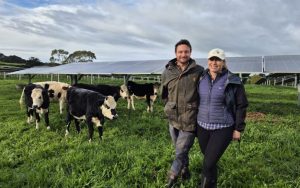
Stagnant global dairy production should keep prices high for New Zealand farmers over the next 12 months, Westpac senior agri economist Nathan Penny says.
A softening of demand for dairy in China because of the Omicron outbreak is likely to be temporary, he told farmers at a field day at Owl Farm in Cambridge.
That softening is being blamed for dairy prices tumbling at the latest GDT auction and subsequent 30 cent revision in Fonterra’s forecast for this season.
Omicron waves usually pass and Penny said he was confident demand will return to that market once the wave was finished.
At the same time, supply will stay tight around the world and this will help underpin prices.
“Come spring, we think underlined prices will rebound as China comes out of its Omicron wave and the key thing around production tightness globally will reinsert itself as the dominant force for prices.”
Interest rates were also rising for the first time in a long time.
While this will impact global growth, it was not as important influence as supply.
Dairy is a staple rather than a luxury product so even when incomes became tighter because of the effect of interest rates, they will still consume it.
“Yes, it matters, but not nearly as much as the supply crunch. That’s the key driver over the next 12-18 months,” he said.
On the downside, inflation and cost increases will continue to impact the farming sector – much more so than the rest of the economy.
This is not a challenge that is going away any time soon, he said.
Dairy incomes are very strong and farmers still had buying power that other parts of the economy did not have.
“I expect the pressure on costs for farmers to be really rough over the next season at least.”
Six months earlier, all of the indicators pointed to a fall in global dairy production and a lift in commodity prices.
There was a drought in the United States, the Ukraine-Russia conflict, high fertiliser, fuel and supplementary feed prices and supply chain issues.
At the same time in China and South East Asia, demand for dairy was taking off and prices followed suit, with record prices for several categories.
That never lasts and over the past few months, a few of those indicators were starting to go the other way, Penny said.
Right now the commodity price cycle is different to the one that occurred in 2014.
It is longer and prices are going to stay higher for longer.
“We’re thinking another $9/kg MS milk price for next year.
“It’s going to be quite different this time round and the key reason for that isn’t any milk around to fill the gap that we have seen during covid.”
Like New Zealand, European dairy producers had their own production issues and their margins are no where near they should be for them to crank up production.
“There isn’t a big supply response coming this year like there was back in 2015. This is going to be a longer cycle and we expect consecutive high milk prices.
“Where is the new normal? The new normal is now $8. There’s still quite a wide range around that, but $8 is the new $6.”
The pandemic accelerated that shift upwards, which was already slowly occurring and now New Zealand was at a new long running milk price.
That acceleration has put the industry in a better position pre- covid.
“We have got a margin to work with but our offshore competitors, for the moment at least, don’t have that luxury.”
























